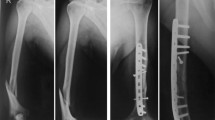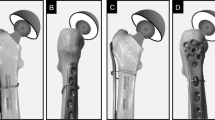Abstract
Introduction
Although the locking compression plate (LCP) system offers a number of advantages in fracture management, its successful use requires careful preoperative planning, consideration of soft tissue dissection principles, and good surgical technique. Failure to address these issues can lead to potential pitfalls. Therefore, there are many reports about potential pitfalls that can arise with inappropriate LCP instrumentation technique. Moreover, these studies may mislead the orthopaedic colleagues that the only important tip in LCP using is its mechanical considerations. But, there is no study about the potential soft tissue pitfalls that may occur. There is an attempt in this study to achieve this objective.
Methods
A prospective analysis was carried out on all patients who were hospitalized for metaphyseal fracture of tibia and LCP fixation was done for them in our trauma center over a 6-month period in 2003. Inclusion criteria included all patients with fracture of tibial metaphysis who were to undergo locking compression plating using long conventional incision (without percutaneus insertion). Therefore, 34 patients included.
Results
Many patients (23.5%) developed severe soft tissue damage with exposed plate, and all of them need flap coverage.
Conclusion
Locking compression plates have a higher profile in comparison to DCP, requiring careful attention to soft tissue. Therefore, inadvisable locking compression plating with conventional incision method and retaining anatomical reduction of the fracture can lead to a higher soft tissue complication in comparison to dynamic compression plating.

Similar content being viewed by others
References
Brown RF (1992) Compound fractures of the tibia: the soft tissue defect. Proc R Soc Med 65:625–626
Chandler RW (1996) Principles of internal fixation. In: Rockwood and Green’s fracture in adults. Lippincott, Raven, USA, pp 452–453
Epps CH JR, Adams JP (1961) Wound management in open fractures. Am Surg 27:766–769
Frigg R (2001) Locking compression plate (LCP) an osteosynthesis plate based on the dynamic compression plate and the point contact fixator (pc-fix). Injury 32(suppl 2):63–66
Gautier E, Sommer CH (2003) Biological internal fixation. Ther Umsch 60(12):729–735
Ger R (1968) The management of pretibial skin loss. Surgery 63:757–763
Murray WR, Lucas DB, Iamm VT (1964) Treatment of nonunion of fractures of the long bone by the two plate method. J Bone Joint Surg 46-A:1027–1048
Sommer C, Gautier E, Muller M et al (2003) First clinical results of the LCP. Injury 34(suppl 2):43–54
Wagner M (2003) General principles for the clinical use of the LCP. Injury 2(B):31–42
Wagner M, Trank A, Frigg R (2004) New concepts for bone fracture treatment and the locking compression plate. Surg Technol Int 12:271–277
Author information
Authors and Affiliations
Corresponding author
Rights and permissions
About this article
Cite this article
Namazi, H., Mozaffarian, K. Awful considerations with LCP instrumentation: a new pitfall. Arch Orthop Trauma Surg 127, 573–575 (2007). https://doi.org/10.1007/s00402-007-0343-6
Received:
Published:
Issue Date:
DOI: https://doi.org/10.1007/s00402-007-0343-6




